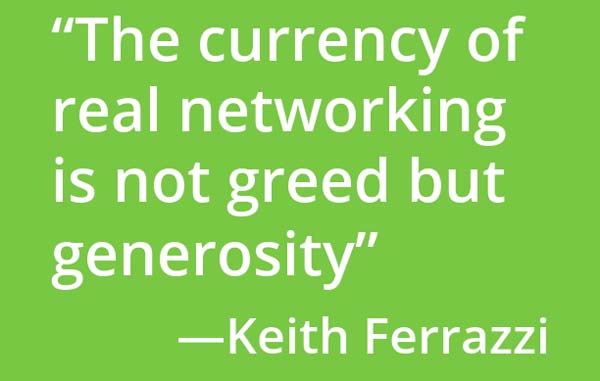Success Advice
7 Relationship-Building Tips from NY Times Bestselling Author Keith Ferrazzi
I recently had the pleasure of connecting with best selling author, entrepreneur, and speaker Keith Ferrazzi, one of the pre-eminent thought leaders and experts when it comes to professional relationship-building.
For those of you who don’t know Keith, he is the New York Times bestselling author of the modern-day classic Never Eat Alone, as well as the author of the bestselling book Who’s Got Your Back?, former CMO of Deloitte (where he was the youngest CMO of a Fortune 500 company), and former CMO of Starwood Hotels before he eventually broke out on his own to start Ferrazzi Greenlight.
These days, he’s helping some of the top companies around the world achieve hard results by teaching soft skills such as relationship building, change management, and supportive coaching, and he’s also making waves with his brand new book, Never Eat Alone: Expanded and Updated, which is available and brand-new as of this week!
Using lessons he’s shared with over half a million readers of the original version of Never Eat Alone, combined with the new insights he’s included in the expanded and updated version of the book, Keith has kindly shared with us 7 of his relationship-building tips that you can use to advance your career on and offline right now.
1) Be The King (Or Queen) Of Content
Those who are super-connectors in their professional and personal lives seek to provide value to others. Whether it’s through sharing lots of relevant industry content and being a learning resource to many like James Altucher, Gary Vaynerchuck, and other successful people have become, or it’s through transparency with your “trade-secrets” that have helped you achieve certain accolades to date, showing your humanity and being of service will result in more meaningful connections for you and your business.
2) Learn To Love The Fringe
In today’s day and age, connections you make online via social media are inherently less “close” than ones you make in-person. However, if managed and utilized properly, this can be a blessing in disguise, as a large, distant network can become an extremely value source of information and opportunities that wouldn’t have been as easily available even just a decade ago.
3) Join Conversations Before You Start Them
Good connectors know when it is valuable to listen and show genuine interest in other people rather than talk and expect others to go out of their way to hear them.
Don’t always jockey for attention, expecting everyone else to flock to you in order to discuss what’s on your mind; instead, join in the discussions others are having on and offline and show sincerity in their concerns and needs while contemplating how you can share knowledge or value in helping them.
4) Don’t Keep Score
If you want to build real connections, it’s never just about getting what you want. It’s about making sure you selflessly provide value to others so they achieve in what they aspire to do as well. There shouldn’t be a “favor trade”, and help shouldn’t be a bargaining chip. Helping others – without keeping score – should be something you want to do in order to make the people around you better and be of service, and as a byproduct, others will naturally be more inclined to help you in the future after you’ve helped them.
5) “Ping” Constantly
Always be reaching out to your network in small, casual, and friendly ways. Whether it’s through sharing a funny meme, an inspirational quote, or inviting someone to join a dinner party (or a workout, meet-up, etc.), constantly reaching out to your network will strengthen bonds you have already while keeping you top of mind with others so that, when an opportunity or potential introduction arises, they automatically think of including you in some way.
If you wait until you need something before getting back in touch, you’re in for a rude awakening.
6) The Best Online Filter Is Offline
The strongest social network relationships begin (or grow) with a face-to-face meeting.
The best connectors get out of their desk chairs and actually go out and meet people in the real world. Only then do they send the friend request or boost their online engagement with that person.
7) Never Eat Alone
I feel obliged to end with this tip from Keith given that it’s the name of his books, but it is also probably the most important one. Just like feeding yourself food, you need to feed your relationships by always keeping them top of mind and working daily to improve them. Making and cultivating relationships your connections can’t be something you only do when you manage to find a little free time. More than ever, it needs to be your #1 priority if you want to distance yourself from the crowd and get ahead in life.
Many, many thanks to Keith Ferrazzi for being kind enough to share these tips with us, and check out his new book, Never Eat Alone, Expanded and Updated: And Other Secrets to Success, One Relationship at a Time, out this week!

Feature Image By: Techonomy Detroit
Did You Know
How Skilled Migrants Are Building Successful Careers After Moving Countries
Behind every successful skilled migrant career is a mix of resilience, strategy, and navigating systems built for locals.

Moving to a new country for work is exciting, but it can also be unnerving. Skilled migrants leave behind familiar systems, networks, and support to pursue better job opportunities and a better future for their families. (more…)
Life
10 Research-Backed Steps to Create Real Change This New Year
This New Year could finally be the one where you break old patterns and create real, lasting change.

Every New Year, we make plans and set goals, but often repeat old patterns. (more…)
Change Your Mindset
The Silent Skill That Makes People Respect You Instantly
What truly earns respect and why most people go about it the wrong way

Everybody craves respect but not everyone earns it. Some people believe that a title, years of experience, or a position of authority automatically entitles them to respect. (more…)
Entrepreneurs
The Essential Skills Every Entrepreneur Needs In 2026
Success in the digital age isn’t about luck. It’s about mastering the skills that separate dreamers from doers.

When I was 22 years old, I started my first side hustle as a ghostwriter. (more…)
-

 Business4 weeks ago
Business4 weeks agoWhy Your E-Commerce Fulfilment Is Probably Broken (And How to Fix It)
-

 Shift Your Mindset3 weeks ago
Shift Your Mindset3 weeks ago11 E’s That Define Every Great Leader And Why Most People Miss Them
-

 Did You Know3 weeks ago
Did You Know3 weeks agoThe Success Patterns You Inherited (And Didn’t Notice)
-

 Entrepreneurs2 weeks ago
Entrepreneurs2 weeks agoThe Essential Skills Every Entrepreneur Needs In 2026
-

 Business3 weeks ago
Business3 weeks agoThe Hidden Money Pit in Your Operations (and How to Use It)
-

 Change Your Mindset2 weeks ago
Change Your Mindset2 weeks agoHow to Turn Your Mind Into Your Greatest Asset (Instead of Your Enemy)
-

 Change Your Mindset1 week ago
Change Your Mindset1 week agoThe Silent Skill That Makes People Respect You Instantly
-

 Life1 week ago
Life1 week ago10 Research-Backed Steps to Create Real Change This New Year



























